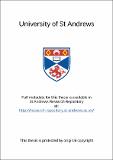Files in this item
Semiconductor diode lasers for picosecond pulse generation
Item metadata
| dc.contributor.advisor | Sibbett, Wilson | en |
| dc.contributor.author | Hughes, David Mason | en |
| dc.coverage.spatial | 189 p | en |
| dc.date.accessioned | 2021-04-08T09:04:27Z | |
| dc.date.available | 2021-04-08T09:04:27Z | |
| dc.date.issued | 2002 | |
| dc.identifier.uri | https://hdl.handle.net/10023/22040 | |
| dc.description.abstract | This thesis describes ultrashort pulse production techniques for semiconductor diode lasers. Three methodologies have been considered: active modelocking, gainswitching and forced Q-switching. The advantages and disadvantages of each technique have been examined. Theoretical assessments of the physical processes governing each procedure were outlined as a basis for the construction of simple yet powerful and adaptable computer simulations. These models were used to predict the temporal behavior of a range of semiconductor devices under broad range of operating conditions. An actively modelocked external-cavity InGaAsP device was used to implement a novel dual-wavelength laser. Continuous wavelength tuning was demonstrated over a 0.5 - 55nm range with the possibility of multiple wavelength operation. Multiple-pulse lasers featured several composite external cavity geometries. Pulse frequencies within a tuning range of 6 - 23GHz were generated using this novel modelocked laser system. The temporal intensity performance of gain-switched DFB and Fabry-Perot laser was assessed and 20 -30ps single feature optical pulses were routinely generated by direct RF modulation of the laser gain. The theoretical model generated optical intensity profiles showing very good agreement with the experimental results Forced Q-switching was implemented for a series of multiple-contact InGaAsP and GaAs diode lasers. Output optical powers were enhanced by the saturable absorption provided by the multi-contact geometry and peak powers of up to lOOmW were demonstrated for symmetrical pulses of-15 - 25ps duration. Pulse timing jitter was considered and distinction made between correlated and uncorrelated timing jitter. Jitter performance was assessed for modelocked, gainswitched and Q-switched regimes. Timing jitter in modelocked lasers was found to be largely correlated (~150fs). Subpicosecond (800fs) jitter was measured at a modulation rate of 2GHz for forced Q-switched multi-contact InGaAsP devices. | en |
| dc.language.iso | en | en |
| dc.publisher | University of St Andrews | en |
| dc.subject.lcc | TK7872.L3H9 | |
| dc.subject.lcsh | Semiconductor lasers | en |
| dc.subject.lcsh | Laser pulses, Ultrashort | en |
| dc.title | Semiconductor diode lasers for picosecond pulse generation | en |
| dc.type | Thesis | en |
| dc.type.qualificationlevel | Doctoral | en |
| dc.type.qualificationname | PhD Doctor of Philosopy | en |
| dc.publisher.institution | The University of St Andrews | en |
This item appears in the following Collection(s)
Items in the St Andrews Research Repository are protected by copyright, with all rights reserved, unless otherwise indicated.

